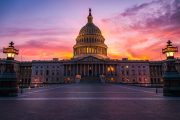
Ohio Governor Mike DeWine (R) has implemented a sweeping statewide mask mandate, which will apply to all individuals over the age of 10, effective July 23, much to the chagrin of constitutionalists and civil libertarians.
Under Governor DeWine’s order, masks are required at any indoor location that is not a residence, outdoors when six feet of social distancing cannot be maintained, and when waiting for, riding, driving, or operating all public transportation, including ride-sharing services. The order includes exceptions for those who have a medical condition or disability and those communicating with individuals with disabilities. It also exempts officiants at religious services, those “actively involved in public safety,” and those who are “actively eating or drinking.”
Governor DeWine has defended his order, claiming the order will help to shape the future of the state.
“We want kids to go back to school, we want to see sports — to do that, it’s very important all Ohioans wear a mask,” he said.
DeWine attributes a reduction in new cases in counties throughout Ohio to increased mask wearing.
Mask advocates contend they were necessary to slow the spread of the coronavirus. Due to shortages in N95 masks and surgical masks, the Centers for Disease Control and Prevention (CDC) recommends homemade cloth masks. According to Ali Mokdad and his colleagues with the University of Washington’s Institute for Health Metrics and Evaluation, if 95 percent of people wore cloth masks when out in public, transmission of coronavirus would be reduced by 30 percent.
But the science is not settled on the effectiveness of cloth masks to slow the transmission of coronavirus. In fact, some evidence suggests just the opposite. According to the first randomized clinical trial studying the efficacy of cloth masks published in April in the journal BMJ Open, individuals who wore cloth masks had significantly higher rates of respiratory infection than those who wore medical masks. The trial observed 1,607 hospital care workers across 14 hospitals in the Hanoi, Vietnam, and found the rate of penetration of cloth masks by COVID-sized particles was almost 97 percent, compared to medical masks at 44 percent. The authors of the study suggested it was likely the cloth masks were problematic because they retained moisture and had poor filtration.
The California Globe also observed that extensive randomized control trial (RCT) studies and meta analysis reviews of those studies have shown that masks and respirators are ineffective against the spread of influenza-like illnesses and respiratory illnesses believed to be spread by droplet and aerosol particles. The Globe cited 10 separate studies that showed wearing masks does not reduce the rate of influenza infections. A pool analysis of 10 “randomized controlled tests” (RCTs) by the Center for Disease Control found “no significant reduction in influenza transmission with the use of face masks.”
“There is limited evidence for their [masks] effectiveness in preventing influenza virus transmission,” they found. This applied to masks “worn by the infected person for source control OR when worn by uninfected persons.” They unambiguously concluded that there was “no significant effect of face masks on transmission of laboratory-confirmed influenza.”
Denis G. Rancourt, Ph.D., explains the science behind this:
It would be a paradox if masks and respirators worked, given what we know about viral respiratory diseases: The main transmission path is long-residence-time aerosol particles (< 2.5 μm), which are too fine to be blocked, and the minimum-infective dose is smaller than one aerosol particle.
At the start of the pandemic, U.S. Surgeon General Dr. Jerome Adams warned that wearing face masks actually increase the spread of coronavirus because of how often they are handled by the wearer. England’s deputy chief medical officer, Jenny Harries, expounded on these claims, asserting masks could “trap the virus” and force wearers to breathe it in.
Jake Dunning, head of emerging infections and zoonoses at Public Health England, told the Independent there was “very little evidence of a widespread benefit” from wearing masks unless they were “worn correctly, changed frequently, removed properly, disposed of safely and used in combination with good universal hygiene behavior.”
Mask advocates contend face masks are particularly important in stopping the spread of coronavirus from asymptomatic carriers, but the World Health Organization said in June that asymptomatic transmission of the virus was “very rare.”
And the more effective N95 respirators pose health risks to the general public, notes infectious disease expert Dr. Amesh A. Adalja, M.D., senior scholar at the Johns Hopkins Center for Health Security in Maryland, who admitted that wearing an N95 mask for too long would affect oxygen and carbon dioxide levels for the wearer.
“Someone wearing an N95 mask for a prolonged period of time may have alterations in their blood chemistry that could lead to changes in level of consciousness if severe,” he told Health.
“It’s uncomfortable to wear, and it does restrict your breathing,” he added. “When I wear one to take care of patients I try to keep it on only for as long as I have to.”
And still, cities, states, and businesses across the country are adopting mandatory mask orders, in some cases, with few exceptions, even for minors and individuals with disabilities or medical conditions.
Earlier this month, residents in Ohio protested against the state’s mandatory mask requirements, gathering outside of the Ohio Statehouse in an event called “Stand for America against Terrorist and Tyrants.”
Fortunately, President Trump has vowed not to issue a national mask mandate, despite being urged by Democrats to do so, asserting he wants Americans to continue to enjoy “a certain freedom.”
“Dr. [Anthony] Fauci said don’t wear a mask, our surgeon general — terrific guy — said don’t wear a mask. Everybody was saying don’t wear a mask, all of a sudden everybody’s got to wear a mask,” Trump continued. “And as you know, masks cause problems too.”
Image: Milos Dimic/iStock/Getty Images Plus
Raven Clabough acquired her bachelor’s and master’s degrees in English at the University of Albany in upstate New York. She currently lives in Pennsylvania and has been a writer for The New American since 2010.




